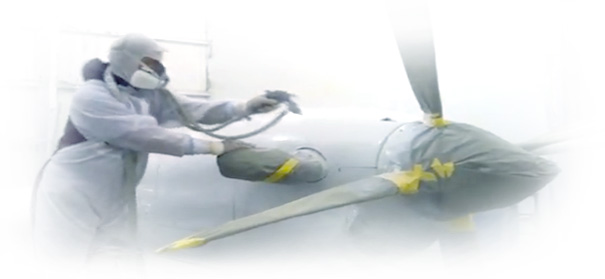
We provide complete custom aviation stripping and painting, touch up and registration number changes to corporate and private aircraft at our hangars located at the St. Lucie International Airport in Ft. Pierce, FL.
Our 18,000 sq foot painting facility and our 4,800 sq foot fully enclosed painting booth provide a controlled atmosphere to produce a quality paint job. All of our processes are compliant with Federal EPA rules and regulations and we are fully insured.
Due to our highly experienced painting team, we have a very low down time and are able to hangar your aircraft safely and securely. Our in-house designer will create your striping detail or your entire aircraft paint design on our computer, giving you the opportunity to view the design before accepting the project. Also, we offer a 2 year warranty on all our aircraft paint services.
Procedure
Our procedures for a basic aircraft strip and paint are as follows. Our team will always keep you posted on the progress of the project and we will secure your airplane while under our control:
Incoming Inspection: The aircraft is inspected upon arrival for evidence of damage. Particular attention is given to the windows, flight controls and fuselage skin. All approved work will be accomplished on a customer approved quotation.
Paint Stripping: Protective masking materials are applied to the aircraft windows, windshield frame, composites, and applicable flight controls. All openings are sealed. The aircraft will be stripped using a EPA compliant materials. The aircraft is cleaned and rinsed with fresh water. Masking materials are removed.
Sanding: The aircraft is sanded as required to remove all paint or primer residue not removed by stripping. Composite parts are sanded as required.
Composites: Applicable composites (fiberglass, fairing, inlet ducts, and radomes) are painted with a black anti-static primer.
Flight Controls: Flight controls (with the exception of spoilers, in the case of most light Jet aircraft) are removed for priming and painting. After final paint is applied, controls are balanced, reinstalled and operationally checked.
Conversion Coating: Protective masking material is applied to proper areas and the aircraft is wiped with a chemical etch, scrubbed, and neutralized with water. Alodine (chromic acid) is applied, left on until color change is evident, and rinsed off. Masking materials are removed.
Primer Application: Protective masking material is applied to proper areas and the aircraft is wiped down with a solvent cleaner. Epoxy corrosion protective primer is applied. Fill primer is applied to the fuselage and tops of wings as needed for cosmetic appearance. Intermediate primer is optional.
Top Coat Application: The primer coat is prepared and protective masking is replaced as required. The aircraft is blown off with high-pressure dry air, wiped down with a cleaner, and wiped with tack cloths. Three coats of high gloss polyurethane paint are applied to the aircraft and the control surfaces.
Landing Gear: The landing gear (struts, gear doors and wheels) are prepped and sanded. Paint is applied to wheels and landing gear unless otherwise specified.
Layout and Stripes: The layout is completed using fine line tape. The layout will be done in accordance with client-approved drawings and will be inspected by the project designer for final layout approval prior to painting.
All operational exterior placards are included. Corporate LOGOS can be generated on premises and painted on the aircraft at the same time, on a time & material basis.
Preflight Inspection: Flight controls are operationally checked and a preflight inspection is accomplished per the aircraft maintenance manual.
